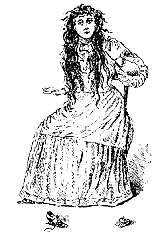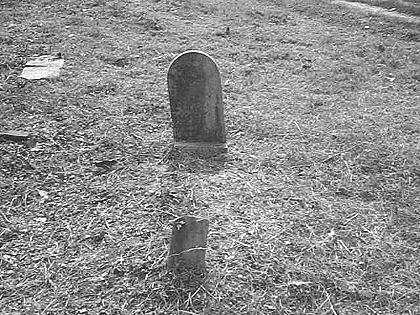The Bell Witch: The Full Account (39 page)

290 P A T
F I T Z H U G H
oath, I might add), and the legend has endured too
long for there not to be anything to it. As is the case
in a court of law, one is presented with evidence and
must draw conclusions of fact. The evidence in the
case of the “Bell Witch” is overwhelming.
Something out of the ordinary did happen in
northwestern Robertson County during the early
Nineteenth Century, and it terrified everyone who
experienced it. I feel that it happened to the Bell
family for the reasons I discussed earlier. Who
knows — if something so incredibly sinister ever
happens again, it just might be your family caught in
the middle of it. Good night, watch those covers, and
pleasant dreams.
THE BELL WITCH: THE FULL ACCOUNT
291
APPENDICES
292 P A T
F I T Z H U G H
Appendix A:
Biographical Sketches of Those
who Figured Prominently Into
the Legend
M ANY PEOPLE FIGURED INTO THE LEGEND
of the “Bell Witch.” Because these people
actually lived and led very interesting lives,
the author has provided biographical sketches of
those he feels played the most prominent roles in the
legend.
John Bell (1750-1820)
Often called “Ol’ Jack Bell” by Kate, John Bell is
the only person in history whose death was
attributed to the doings of a Spirit. In 1817, Bell
contracted a mysterious affliction that worsened over
the next three years, ultimately leading to his death.
Kate took pleasure in tormenting him during his
affliction, finally poisoning him one December
morning while he lay unconscious after suffering a
number of violent seizures.
Born in Edgecombe County, North Carolina, John
Bell apprenticed as a barrel maker during his
formative years and later pursued a career in
farming. He married Lucy Williams in 1782 and
settled on a farm he had bought earlier. The Bells
prospered over the next eight years and were among
the most successful planters in the Tar River area of
North Carolina.
THE BELL WITCH: THE FULL ACCOUNT
293
With the birth of their first child, Jesse, they began
a family. In the years that followed, John and Lucy
Bell had three more sons, John Jr., Drewry, and
Benjamin. All went well with the Bells until the 1801
and 1803 crop seasons when their crops failed and
they decided to move westward and join their friends
who had started successful farms there.
In the winter of 1803-1804, John Bell and his
family embarked on a journey over the treacherous
mountains of North Carolina and east Tennessee to
an area known as “The Barren Plains,” settling in the
northwest section of present-day Robertson County,
Tennessee. Bell became a successful farmer and
gained considerable respect in his new abode. He
later became an Elder of Red River Baptist Church.
The affliction that John Bell was stricken with in
1817 was most likely a neurological disorder. Very
little was known about such disorders during the
early Nineteenth Century, thus few treatment options
were available.
It is interesting to note that Sir Charles Bell, a
Nineteenth Century anatomy professor, discovered a
neurological disorder that yielded symptoms almost
identical to those John Bell suffered at the onset of
his affliction.
This usually non-fatal disorder is known as “Bell’s
Palsy,” and was discovered several years after John
Bell’s death. The fact that John Bell’s earliest
symptoms mimicked those of Bell’s Palsy, a disorder
named for the Bell surname, is coincidental.
John Bell died on December 20, 1820, and is
buried in the old Bell Cemetery near Adams,
Tennessee along with his wife and some of their
children.

294 P A T
F I T Z H U G H
Lucy Bell (1770-1837)
Born in Edgecombe County, North Carolina to a
family of wealthy planters, Lucy Bell was a pleasant
and mild-mannered woman who was nearly always
on Kate’s good side.
All throughout her reign of terror over the Bell
family, Kate pretended to treat Mrs. Bell nicely –
singing to her, bringing her food when she was sick,
and comforting her in other times of need. The
emotional damage suffered by Mrs. Bell because of
having to see and hear Kate’s acts of physical abuse
towards her husband and daughter offset any good
deeds that Kate performed for her.
After John Bell’s death and estate settlement, Lucy
Bell inherited one slave, Dean, and a 106-acre tract
of land that included the Bell home and cemetery.
She remained at the old homestead up until her
death in 1837. Lucy Bell is buried in the old Bell
Cemetery near Adams, Tennessee along with her
husband and some of their children.
Elizabeth “Betsy” Bell (1806-1888)
Like her father, Elizabeth Bell
suffered a great deal from Kate’s
acts of physical abuse by
having her hair pulled and
getting slapped and pinched to
the point that her face and
arms covered with welts and
bruises. 58 Kate never gave a
reason for her relentless abuse
of Elizabeth, but she
emphatically disapproved of her
engagement to Joshua Gardner.
58 Elizabeth Bell’s photo from
Authenticated History of the Bell Witch
, M.V. Ingram, 1894.
THE BELL WITCH: THE FULL ACCOUNT
295
Elizabeth broke off her engagement to Joshua in the
spring of 1821 after enduring several years of ridicule
about her decision to marry him.
Elizabeth Bell married her former schoolteacher,
Professor Richard Powell, in March of 1824, settling
a few miles from the Bell farm and near a community
that later became known as “Cedar Hill.” Elizabeth
Powell became a homemaker and the mother of eight
children. Only four of Elizabeth and Richard Powell’s
children reached adulthood, one of which was
Leftrick Reynolds Powell. He died in the Civil War
Battle of Franklin, Tennessee in November of 1864 at
the age of 23.
Elizabeth was very supportive of her husband’s
political career and stayed by his side during his
many bouts with misfortune, including a debilitating
stroke in 1837 and his ensuing loss of $10,000 in a
steamboat accident while attempting to raise money
for their family’s financial well-being. Elizabeth
insisted that her marriage to Richard Powell was a
very happy and fulfilling one, despite the hardships
they were forced to endure. Richard Powell’s health
declined over the years following his stroke, and he
died in January of 1848 at the age of 53.
In 1849,
The Saturday Evening Post
published a
story believed by many to be the first commercially
published account of the “Bell Witch.” The story
implicated Elizabeth as having been the culprit
behind the “Bell Witch” disturbances. This angered
her to the point that she threatened the publication
with a libel suit if it did not retract its statements. A
public apology and retraction of the comments
appeared in a later edition of
The Saturday Evening
Post,
and as such, the case never went to trial.
Elizabeth Powell remained in the Cedar Hill area
for many years after her husband’s death and had
the reputation of being a very witty and personable

296 P A T
F I T Z H U G H
lady. Later in life, she gained considerable weight
and a number of health problems befell her as a
result. She was ultimately forced to move to
Yalobusha County, Mississippi in 1874. She lived
out her final years with a daughter, Eliza Jane
Powell, who had moved to the area from Tennessee
about 1849.
It was said that Elizabeth Powell refused to discuss
Kate with people outside the family all the way up to
the time of her death. It has also been said that she
was terrified of sleeping alone and that she always
slept between the wall and another person.
Elizabeth “Betsy Bell” Powell died on July 11, 1888
at the advanced age of 82 years. She is buried in
Long Branch Cemetery near Water Valley,
Mississippi along with Eliza Jane Powell and a son-
in-law, Z.Y.X. Bell.
This is the grave of Elizabeth “Betsy Bell”
Powell. The gravestone in the picture is the
original, and contains a beautifully designed
inscription. After this picture was taken in
1999, the original stone was replaced with a
generic stone.
THE BELL WITCH: THE FULL ACCOUNT
297
Dean
Dean, John Bell’s most prized slave, often reported
encounters with Kate. His encounters included
being followed by a black dog with two heads, being
turned into a mule, and having his head split open
by a large rabbit.
He carried a large scar on his head after the
incident with the rabbit, and often told people it was
the work of Kate. It is believed that his scar was
really the result of a severe beating he received at the
hands of a local planter who “rented” him from John
Bell to do some farm work. Bell was reportedly
outraged by the planter’s cruelty and pursued legal
action as a result.
An honest and dependable field slave, Dean was
noted for his precision with the axe. Despite his
small frame, Dean could take one side of a tree
against any two men on the other side and cut a
deeper kerf. His axe reportedly even split a dog’s
head open, causing it to appear to him with two
heads from that point forward. It was also his axe
that he was looking for when Kate reportedly turned
him into a mule.
Dean, who also mastered the Bells’ wagon from
North Carolina to Tennessee, was one of two slaves
who moved to Tennessee with the Bells. The other
slave was Chloe, his mother, who was 42 years of age
at the time. Chloe had worked for Lucy Bell’s father,
John Williams, in North Carolina before being given
to the Bells upon his death.
It is presumed that Dean and his wife are buried
in two of several unmarked slave graves in the old
Bell cemetery near Adams, Tennessee. They have
many descendants living in the same area today.
The exact date of Dean’s death is unknown.
